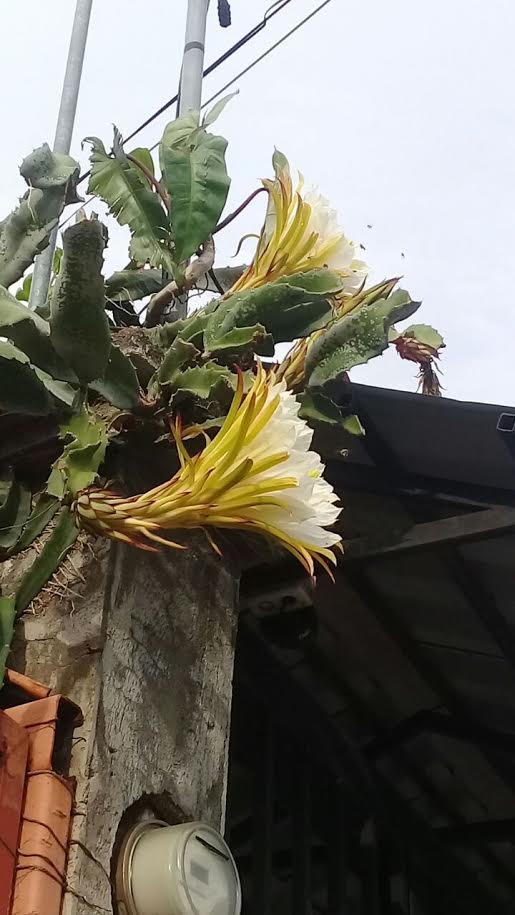Don't wanna be here? Send us removal request.
Photo

Emmanuel Castro
9-A
Flower: Selenicereus hamatus
Observations:
The bees came and pollinated the flower, then they left.
How this plant adapted their flowers to attract their pollinators:
Pollinators characteristics: Perception of bilateral symmetry, blue and yellow colors and ultraviolet light; dexterity at manipulating plant parts, ability to strongly vibrate by buzzing, need for both nectar and pollen.
Flowers characteristics: Flowers with bilateral symmetry, often in shades of blue or yellow, nectar guides in the ultraviolet spectrum, flowers that require dexterity to open, sometimes bell-shaped flowers.
As we can see, the flower has some of the characteristics mentioned. The reason the plant evolved this way is for bees to be more interested in pollinating it.
References (APA):
Arnet, J. (2014). Washington Native Plant Society Blog. Coevolution and Pollination. Retrieved from: https://www.wnps.org/blog/coevolution-and-pollination
1 note
·
View note
Photo


Lucía Sánchez Saborío
9-A
Flower: Penta
Observations:
The bees come, mostly during the day, pollinate the flower and go on their way.
How this plant adapted their flowers to attract their pollinators:
Normally, bees are attracted to flowers with bilateral symmetry, often in shades of blue or yellow, nectar guides in the ultraviolet spectrum, flowers that require dexterity to open, sometimes bell-shaped flowers. However, as can be seen in the image, they are also attracted to the pink color to be able to pollinate or take the nectar.
These pollinating bees normally have characteristics that identify them, such as the perception of bilateral symmetry, blue and yellow colors and ultraviolet light; ability to manipulate plant parts, ability to vibrate strongly due to hum, need for nectar and pollen.
References (APA):
Arnet, J. (2014). Washington Native Plant Society Blog. Coevolution and Pollination. Retrieved from: https://www.wnps.org/blog/coevolution-and-pollination
1 note
·
View note
Photo

José Pablo Monroy
9-A
Flower: Lantana
Observations:
That butterfly every day appears in the garden.
How this plant adapted their flowers to attract their pollinators:
Pollinators like bees and butterflies are important for plant reproduction. One way to keep these pollinators happy is to attract and feed them. Lantana is a sun-loving, warm weather plant that’s great for attracting these pollinators.
Lantana should be planted in a place where they’ll get six or more hours of sun to keep them blooming all summer. These plants would be happy in pots or planted in the ground, and aren’t too picky about soil, as long as they do not go dry. They don’t require much fertilizer either.
References (APA):
News 19. (2020). Sun-loving Lantana brings pollinators to your garden. Retrieved from: https://whnt.com/community/garden-tips/sun-loving-lantana-brings-pollinators-to-your-garden/#:~:text=Pollinators%20like%20bees%20and%20butterflies,great%20for%20attracting%20these%20pollinators.
1 note
·
View note
Photo


Fabián Ramírez Hidalgo
9-A
Flower: Lantana
Observations:
The butterfly collected the nectar from different flowers and then left.
How this plant adapted their flowers to attract their pollinators:
Its main pollinators are butterflies, this is because this plant has a sweet smell of nectar, yellow and orange blooms, and it has flat or dome-shaped clusters of small tubal flowers that butterflies can safely perch on as they drink the sweet nectar.
This plant also attracts hummingbirds and Sphinx moths.
References (APA):
Amela, M., Aquino, D., Bauza, A., Chamer, M., Grohar, M., Herrera, A., Hoc, P., Lafuente, M., Míguez, M., Scorza, V. (2013). Biología Floral de Lantana camara L. (Verbenaceae). Retrieved from: https://www.researchgate.net/publication/331872103_Biologia_Floral_de_Lantana_camara_L_Verbenaceae
Larum, D. (2018). Lantana Plant And Butterflies: Does Lantana Attract Butterflies. Retrieved from: https://www.gardeningknowhow.com/ornamental/flowers/lantana/lantana-and-butterflies.htm
2 notes
·
View notes